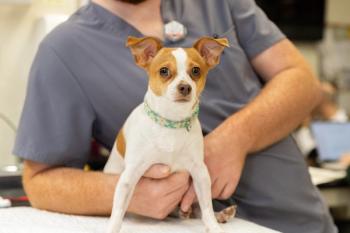
Do tests first: Pre-surgical blood work may eliminate variety of surprises
Could this happen to you? It had been a busy Monday morning for surgery. Somehow our practice team had managed to repair a fractured femur in a German Shepherd, perform a cystotomy on a Schnauzer, remove an eyelid tumor from a Spaniel, and still manage to continue therapy on several ongoing hospital cases.
Could this happen to you? It had been a busy Monday morning for surgery. Somehow our practice team had managed to repair a fractured femur in a German Shepherd, perform a cystotomy on a Schnauzer, remove an eyelid tumor from a Spaniel, and still manage to continue therapy on several ongoing hospital cases. Add to that workload the task of taking intermittent radiographs of a barium upper GI series on a vomiting Poodle. And we had a Pomeranian spay that got squeezed into the schedule.
As noon approached all was going well when suddenly a technician exclaimed, "The Pom is not waking up properly." A quick exam revealed a low body temperature and prolonged capillary refill time. Lab work was immediately ordered. Results showed a very low total protein and glucose and an extremely low BUN. A technician was assigned to sit cageside and monitor the IV drip and critical signs. Lunch hour was postponed and before much time had passed the afternoon appointments started arriving.
Using in-house equipment, a staff member can perform testing on the day of the surgical procedure providing convenience for the client and efficiency for the clinic. Veterinary assistant Lydia Gerard, of Sulphur Springs Veterinary Clinic, is performing a pre-anesthetic test for the "next up" patient. Spreading the testing throughout the surgery block may improve efficiency for smaller practices. While the doctor and surgery tech are busy with one surgery another tech or veterinary assistant may be free to perform the tests for the next procedure.
The good news is that the Pomeranian eventually recovered and was discharged the next day. The bad news is that the staff had to work frantically to catch up and had a miserable day, especially trying to make peace with the owner. Worse yet was the fact that a portosystemic shunt was ultimately diagnosed and the dog was eventually euthanized.
The owner was shocked that we were not aware of the fact that the pup had a portosystemic shunt prior to performing surgery. This was, of course, the same owner who had elected not to have the optional pre-anesthetic test performed!
This frantic morning, and the stress that accompanied it, could have been avoided had we performed the pre-anesthetic tests. We had recommended them, and the owner had refused them, but we did the surgery anyway. After this episode it is easy to see why we initiated mandatory pre-anesthetic testing. Now, six years later we are still doing these tests and have seen many cases that easily could have gone this route.
Make pre-anesthetic testing mandatory
Consider establishing pre-anesthetic testing as an across-the-board policy to be followed for all surgery cases. This means doing the testing for elective, as well as non-elective procedures and for younger, as well as older animals. In fact, it is the elective procedures performed on the younger animals that seem to be the most ignored. The concept that most young animals will do well regardless and therefore, risks are low making pre-anesthesia testing unnecessary is not a sound philosophy. It is not just about preventing anesthetic deaths, which are fortunately less common in most practices today (perhaps a credit to better anesthesia technology), rather it is more about reducing the cases that just don't seem to recover as quickly or the cases that have several owner call-backs. It is time to take a more cautious look at all our surgery patients, eliminating all surprises during anesthesia, post-anesthesia, or even eliminating those occasional, exasperating reports discovered in the overnight FAX tray sent from the local emergency clinic.
Table 1: Pre-Anesthetic Blood Panels For Small Animal Practice
However eliminating all surprises implies testing all animals. Simply offering pre-surgical testing as an option is not getting the job fully accomplished. For a testing program to be effective it must be performed on all cases and that requires it to be non-optional, or in reality, mandatory. What good is a testing protocol if the tests are not performed?
Pre-anesthetic testing reduces office stress
By making pre-anesthesia testing mandatory it simplifies office policy, actually placing less stress on the support staff. Staff members no longer spend time and energy repeatedly recommending the testing to ambivalent clients. By adopting mandatory testing the whole practice team is expressing an easy and consistent message. If it is important for one pet to have pre-anesthetic testing it should be important for all pets. Most clients do not have medical expertise and therefore should not be placed in a position of making a decision about the value of testing for their pets. In the author's practice mandatory pre-anesthesia testing has been a policy for more than five years and the entire staff is not only supportive but also proud of the idea.
What constitutes pre-surgical blood testing?
The number of tests to include could arguably include many tests. In fact performing a complete profile for every procedure would be ideal yet probably not cost effective. Therefore, in efforts to balance value to the doctor and affordability for the client, the protocols in Table 1, p. 12 have been developed and successfully employed in the author's practice.
Blood work only part of the picture
As with all laboratory work, a physical evaluation and reference to patient history are essential. A brief questionnaire can be developed for the client to quickly review and provide current information. A physical exam form containing key exam prompts can be constructed and completed immediately prior to surgery. Beyond adding more blood tests one could easily make an argument for performing a mandatory pre-surgical ECG. But for the time being pre-surgical laboratory testing provides a wealth of information and is still far from being commonplace and therefore needs to be addressed.
Several reasons to delay surgery
There are numerous conditions where delaying or avoiding an elective procedure may be sensible. Consider finding an elevated WBC. Should an animal that may be harboring an upper respiratory infection be anesthetized and have surgery? It would be far better to delay surgery, search for a cause and attempt to provide treatment. For example, after identifying a respiratory infection in a young spay candidate, a treatment program involving antibiotic therapy could be instituted. After an appropriate period of treatment, the pet can return for laboratory re-evaluation and again be considered for surgery. Consider finding a low hematocrit. Is there a bleeding disorder or some parasitism present that may delay recovery? Or consider finding a low platelet count. Will the animal be able to produce good blood clots post-operatively? Discovering poor kidney or liver function commonly seen in older animals may occasionally be seen in younger animals as well.
Table 2: Six-Month Study on Abnormal Blood Work
Consider older animals presented for an elective dental prophy. Is there marginal kidney function present? How will the period of anesthesia and its associated reduction in renal perfusion affect this marginally functioning kidney? Remember that the pet may have been withheld water the preceding night, further stressing this older pet's kidneys. Also consider doing an elective dental prophy on a senior age cat. If this cat happens to be hyperthyroid there may be a serious anesthesia risk. Furthermore, the hyperthyroidism may be masking chronic renal failure.
Numerous diabetic animals have been discovered by pre-anesthetic lab work at the time of surgery or dental prophy. Surprisingly some of these are young animals undergoing a spay or neuter procedure.
Pre-anesthetic lab for dentals and other simple elective procedures routinely identifies hypothyroid individuals. In the author's practice finding elevated liver enzymes, ultimately leading to a diagnosis of hypothyroidism, is the most frequent discovery of pre-anesthetic screening.
Delaying the procedure makes good medical sense. It is an example of a win-win-win scenario. While being concerned about their pet the client is pleased that the veterinarian cared enough to postpone the procedure. The pet benefited by the discovery and treatment of an unknown disorder as well as the reduction in risks associated with the procedure. There was no monetary loss to the practice owing to the income generated by the repeat lab work.
Occult disease as a threat
In the author's practice approximately 10 percent (13 out of 128) of all presumed-to-be-normal pets have some abnormality that constitutes a rational reason to delay or forego the procedure. Another 11 percent (14 out of 128) had a blood abnormality that altered the anesthetic program. Alterations included using sedation accompanied by local anesthesia instead of general anesthesia or preloading with intravenous fluids and other changes to the protocol or associated care of the pet (Table 2, p. 14).
In-house lab makes it all work smoothly
An in-house lab is most useful for convenient pre-surgical testing. The availability, reliability and economy of utilizing in-house laboratory equipment today make this a necessity for a busy practice. Owners can conveniently drop off their pets on the morning of the procedure, avoiding repeated trips to the clinic. The blood tests can be quickly performed on the morning of surgery providing valuable up-to-the-minute information. A copy of the report can be sent home with release instructions. This provides the owner with data that may be good baseline information for the future. It also helps educate owners on the concept of lab testing that may increase compliance on future wellness screening.
Philosophical issues
Doing pre-anesthetic testing imparts some valid philosophical perspectives as well. Some valid points must be made here.
1. Consider the emotional impact to the owner scheduling an elective procedure such as spay or neuter. It may well be the only time in this particular pet's life that he or she will have surgery performed. Shouldn't it be carried out under the safest possible conditions?
2. Elective procedures are, simply stated, elective procedures. Why perform an elective procedure on a pet with an identifiable problem, a problem that might be easily treated with some short-term medical therapy?
3. For elective spays and neuters, client expectation for success is very high (also the fee is usually very low!). For example, clients consider a spay a simple in-and-out procedure and not an abdominal surgery that entails probing through visceral, ligating blood vessels and uterine stumps, and removing body organs. Client's perspective is "It's only a spay; how could there be problems?" Addressing this high expectation requires avoiding all possible risks. Practitioners have nothing to gain and everything to lose when they approach an elective procedure that carries such high client expectations.
4. There is also a risk of damaging the doctor-client relationship. It makes more sense to delay the surgery, investigate the abnormality and treat the condition before proceeding with an elective procedure. Clients trust our judgment and expect us to act accordingly.
Conclusion
Performing mandatory pre-anesthesia lab testing is an essential step for providing good medical care, maintaining client trust, as well as avoiding stressful situations for doctor and staff. Studies have shown repeatedly that clients will accept it, anesthesia is safer because of it, staff members appreciate it, and practices produce more income by doing it. Yet with all the aforementioned knowledge most clinics are still struggling with whether it should be mandatory and sadly, some clinics are not even offering it as an option.
Suggested Reading
Newsletter
From exam room tips to practice management insights, get trusted veterinary news delivered straight to your inbox—subscribe to dvm360.





